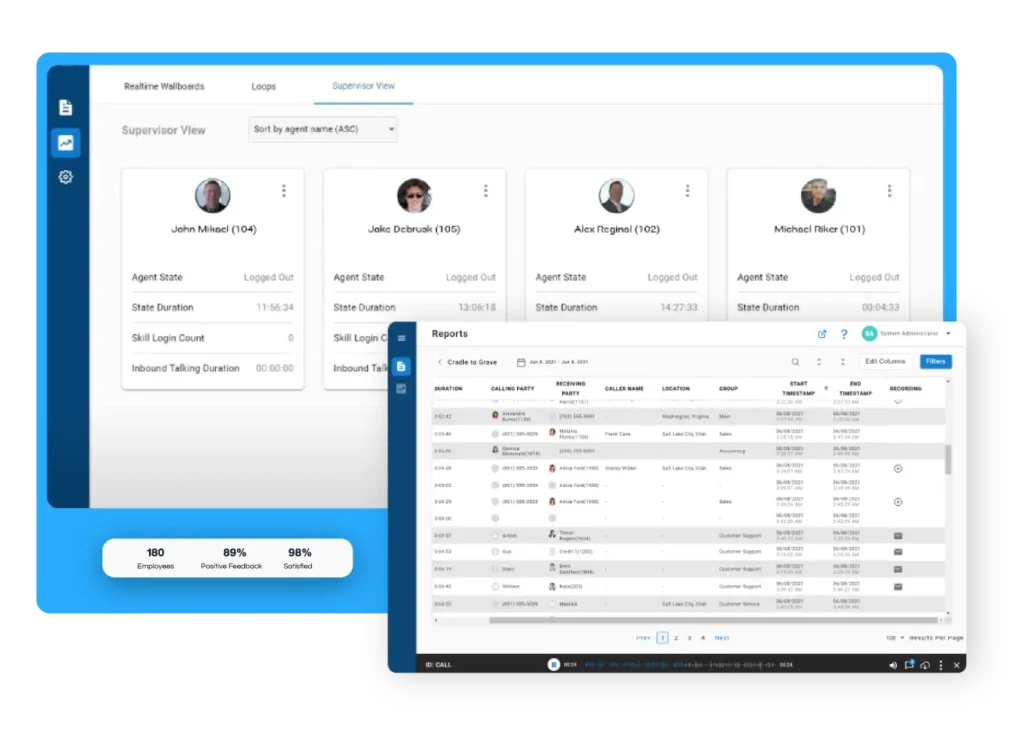Retail contact centers walk a tightrope: deliver fast, helpful service—but keep labor costs under control.
And that tightrope is getting thinner. As more customer interactions shift online, contact centers are now the front lines of the customer experience. Without in-store staff to answer questions, resolve complaints, or guide a buyer toward a decision, the burden falls squarely on your service teams—especially across chat and voice.
Support teams are under pressure to deliver faster answers, shorter wait times, and consistent service across every digital channel. But more agents isn’t always the answer. Often, what retailers need is smarter scheduling, clearer data, and automation that works.
AI-powered workforce optimization helps retailers get ahead of service issues without bloating their headcount—especially during those moments when demand spikes fast.
The Real Problem: Volume Spikes and Rigid Staffing
Retail contact centers don’t deal with steady-state support. They deal with waves—product launches, website glitches, trending promotions, and yes, seasonal surges. The challenge isn’t just high volume, it’s unpredictability.
When staffing plans can’t flex, agents get overwhelmed, queues grow, and CX suffers. Nothing pushes agents out the door faster than constant overload.
More visibility into channel activity and queue patterns helps managers adapt in real time—avoiding both overstaffing and reactive firefighting when volume suddenly climbs. Real-time analytics and reporting are key to making that shift.
What Smart Retailers Are Doing Instead
Rather than throwing more people at the problem, forward-thinking retail teams are reworking how they manage support day-to-day:
1. Automate Common Interactions With AI Chat
From shipping updates to return policies, a huge portion of inquiries are predictable. With an AI Messaging Bot in place, those can be answered instantly—without involving a live agent.
That reduces total volume, keeps queues moving, and allows your team to focus on customers who truly need hands-on support.
2. Use Live Data to Guide Scheduling
Retail volume doesn’t follow a set pattern. Even on a “quiet” week, an email blast, delivery issue, or social media trend can suddenly drive a wave of inquiries.
By using historical trends and real-time dashboards, managers can make informed scheduling decisions on the fly—adjusting shift coverage, reassigning team members, or pulling in backup before a backlog builds.
3. Route Smarter to Reduce Escalations
Not every agent should handle every inquiry. When all customers are funneled into one queue, high-value orders and time-sensitive requests get delayed.
Smart routing rules help direct inquiries based on complexity, customer type, or topic—so the right person answers the right question faster. It’s not just about speed—it’s about improving resolution and satisfaction across the board.
4. Monitor and Support Agent Performance in Real Time
Staffing isn’t just about the schedule—it’s about what happens during every shift. Real-time insight into handle times, queue status, and agent availability helps supervisors make faster decisions when demand shifts unexpectedly.
This allows teams to stay flexible, identify issues early, and step in with coaching or support when agents show signs of struggle—creating a healthier work environment and more consistent customer outcomes.
5. Focus on the Right Metrics, Not Just More Metrics
Retail support teams are often flooded with dashboards—but not all metrics are equally meaningful. Having clear visibility into the right KPIs—like response time, resolution rate, or queue length—helps frontline leaders manage performance without getting bogged down in noise.
When every team member sees the metrics that matter to them, alignment improves, performance becomes easier to manage, and service quality improves across the board.
You Don’t Need More People—You Need Better Alignment
Smarter workforce management creates a multiplier effect: fewer bottlenecks, more productivity, and happier agents who aren’t burned out by avoidable volume.
You don’t need more people. You need better alignment between customer demand and agent response.
Retailers that optimize workflows—not just headcount—are better equipped to handle whatever the day throws at them, from flash sales to sudden technical issues.
And because the tools to support this don’t require major infrastructure changes, results can be fast, measurable, and easy to scale.
Final Thought: Do More With the Team You Have
You don’t need to out-hire the problem. You need to outsmart it.
Smarter scheduling, clearer data, and the right automation allow retail support teams to deliver better experiences—without constantly expanding their workforce.
Instead of running to keep up with every service spike, you’ll be able to anticipate, adapt, and align in real time.



